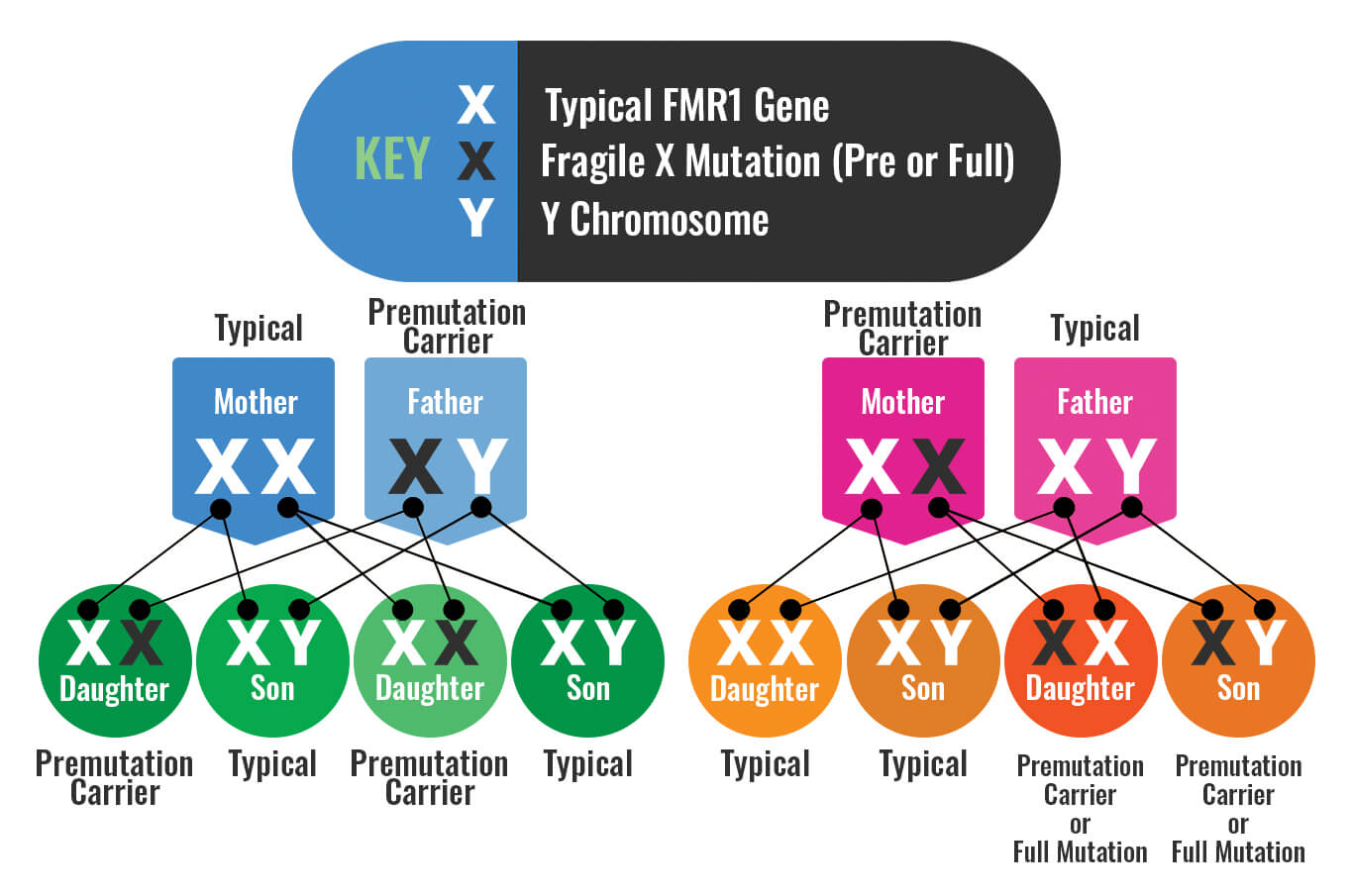What is Fragile X?
Fragile X is an umbrella term that covers several related conditions caused by changes in the same gene. This includes people with a “premutation” (sometimes called carriers), those with the full mutation called Fragile X syndrome, and two adult-onset conditions known as FXPOI (Fragile X-associated primary ovarian insufficiency) and FXTAS (Fragile X-associated tremor/ataxia syndrome). Fragile X syndrome is the most well-known of these and is the most common inherited cause of intellectual disability and autism.
When the FMR1 gene on the X chromosome doesnʼt work properly, it can cause learning difficulties, speech and language issues, and behavioral challenges such as anxiety or hyperactivity. People with Fragile X syndrome often have trouble with social situations and may repeat certain behaviors or be sensitive to loud sounds, crowds, or bright lights.
People with the premutation, who may seem unaffected, can sometimes experience milder symptoms or develop the adult conditions FXPOI (which affects womenʼs reproductive health) or FXTAS (which causes tremors and cognitive problems).
An estimated 1.5 million Americans are carriers of a Fragile X mutation. Fragile X can be accurately diagnosed with a simple blood test called the FMR1 DNA test, which must be ordered by a genetic counselor or physician.
While thereʼs no cure for any of these conditions, early intervention with speech therapy, special education, and behavioral support can help people with Fragile X syndrome learn new skills and lead fulfilling lives.
A Guide for the Newly Diagnosed and Those Already Living with Fragile X
This guide helps answer common physical, cognitive, and behavioral questions. You’ll also learn:
— How Fragile X is inherited.
— Available treatment options.
— How females are affected vs. males.
— About the support you can receive from the NFXF.
Fragile X Conditions
There are four known FX conditions.
Fragile X Syndrome (FXS)
Fragile X syndrome is an inherited genetic condition caused by a full mutation of the FMR1 gene (>200 CGG repeats) that may cause intellectual disability, behavioral and learning challenges, and various physical characteristics.
Many behaviors are positive, and it is those behaviors you will see most often in addition to challenging behaviors. Behavior problems serve a purpose (or function) and are often a form of communication. Addressing behavioral challenges in an individual with FXS should start with a comprehensive evaluation. A proactive approach with appropriate supports and accommodations will likely foster positive outcomes and set up the individual with FXS to succeed in their home, school, or community.
Behavioral challenges may include:
- Anxiety, hyperactive behavior, fidgeting, impulsive actions, and ADHD.
- Stereotypic movements (such as hand-flapping), limited eye contact, shyness, memory problems, difficulty with face recognition, and sensitivity to noise and crowds.
- Sensory sensitivities to bright lights, loud noises, and certain clothing textures.
Physical characteristics may include a long and narrow face, large ears, prominent chin and forehead, flexible joints, and in males, enlarged testes after puberty. Some individuals may also have mitral valve prolapse (heart condition).
FXS is also the leading known inherited cause of intellectual disability and autism.
The Fragile X Premutation
Individuals with the Fragile X premutation, also known as a Fragile X carrier, have a partial mutation of the FMR1 gene (55-200 CGG repeats), and may pass it, or an expanded version, on to their children.
A note about the term “carrier”: Traditionally, a carrier of a genetic mutation is defined as a person who inherits an altered form of a gene but shows no effects of that mutation. However, in Fragile X, this definition does not exactly fit. Those with the Fragile X premutation — carriers — are at risk of developing certain adult-onset conditions like FXTAS and FXPOI. And while they often show no effects, issues sometimes seen in premutation carriers include high blood pressure, migraine headaches, depression, anxiety, hypothyroidism, fibromyalgia, and sleep apnea.
Learn more about the Fragile X premutation
Fragile X-Associated Tremor/Ataxia Syndrome (FXTAS)
FXTAS (pronounced: FAKS-taz) is an adult-onset neurodegenerative disorder, more common in males than females with the FMR1 premutation. FXTAS is associated with tremors, balance problems, and other neurological signs. The risk of developing FXTAS in any given individual is influenced by their CGG repeat size, sex, and age.
Fragile X-Associated Primary Ovarian Insufficiency (FXPOI)
FXPOI (pronounced: FAKS-poi) is a condition where the ovaries are not functioning at full capacity in a female with the FMR1 premutation, which can cause infertility, early menopause, and other ovarian issues. FXPOI occurs in about 20%–30% of females with the FMR1 premutation.



Frequently Asked Questions
Is Fragile X considered a rare disease?
Rare diseases are defined as affecting fewer than 200,000 individuals in the U.S. Yes, Fragile X syndrome is considered a rare disease because it affects around 100,000 males and females. However, the Fragile X premutation is found in more than a million males and females, so is not considered a rare disease.
How do you diagnose Fragile X?
Fragile X is diagnosed through a simple blood test commonly referred to as the FMR1 Fragile X DNA test. A healthcare professional sends a blood sample to a laboratory.
The laboratory results typically report the number of CGG repeats within the FMR1 gene. The number of repeats may fall into the normal, intermediate, premutation, or full mutation range. For full mutations (Fragile X syndrome), they also report the methylation status and, if detected, the presence of mosaicism.
AGG analysis is often ordered as a follow-up test when a premutation or intermediate result is reported in women who plan to have children. Testing for AGG interruptions can be done as a separate test and is most relevant as part of carrier (premutation) testing.
The FMR1 Fragile X DNA test is considered the standard of care for determining the presence of Fragile X. DNA testing detects more than 99% of individuals (both males and females) with FXS and the Fragile X premutation.
Learn more about testing and diagnosis
Do other conditions benefit from Fragile X research?
Yes, there are ongoing clinical trials and industry partners currently working on treatments for Fragile X and the following conditions, which can benefit each other:
- Alzheimer’s Disease
- Parkinson’s Disease
- Down Syndrome
- Autism
- Cystic Fibrosis
- Polycystic Ovarian Syndrome
- Epilepsy
- Amyotrophic Lateral Sclerosis
Learn more about Fragile X research
Is there a cure for Fragile X?
Not yet. Researchers have been working on gene therapies as long-term treatment options. There are also several interventions in clinical trials. Until they are successful, doctors can only treat the symptoms of the Fragile X conditions with approved interventions.
While there is currently no cure for Fragile X syndrome, there are treatments and interventions that can improve the lives of individuals living with FXS and their families. Many families choose a combination of treatment interventions that may include medications or non-medication-based treatments, behavioral and other interventions, and school supports. What works for one person may not work for another. With the right combination, all individuals with FXS can make progress!
Learn more about treatment interventions
What is the lifespan for someone with Fragile X?
The life span for people with FXS is not affected because there are usually no life-threatening health concerns associated with the conditions. We continue to learn more about what aging with FXS looks like as more research is done.
What is the science behind Fragile X?
Everyone has an FMR1 gene, the difference between having Fragile X and not having Fragile X comes down to CGG repeat number.
In the DNA of the FMR1 gene, there’s a repeated sequence of chemical bases known by the letters CGG. This sequence repeats multiple times and with different repeat ranges. When an atypical expansion occurs on the FMR1 gene, the genetic code is altered and changes the gene’s function.
You may hear the terms atypical expansion and mutation used interchangeably. They are both used to describe a change on the FMR1 gene. Everyone has the FMR1 gene on their X chromosomes, it just functions differently depending on how many CGG repeats there are.
Learn more about genetics and inheritance
How is Fragile X passed down in families?
Females with the Fragile X premutation have a 50% chance of passing the mutation to each of her children, while males will pass it to all of their daughters (and none of their sons).

Given the complexity of Fragile X inheritance, it is very important that families living with Fragile X-associated conditions meet with a genetic counselor or geneticist to review the meaning of a positive lab report for the individual and their extended family.
Learn more about testing and diagnosis
How common is Fragile X?
There have been several studies aimed at determining the prevalence of FXS. The current agreed upon prevalence of FXS is:
- Males — approximately 1 in 4,000 to 1 in 7,000
- Females — approximately 1 in 6,000 to 1 in 11,000
According to a 2012 study by the CDC, the frequency of the Fragile X premutation in the U.S. is:
- Males—approximately 1 in 468 males (~320,000)
- Females—approximately 1 in 151 females (~1 million)



Printable Resources

Our collection of checklists, e-books, fact sheets, handouts, templates, awareness cards, the FDA PFDD Meeting Final Report, and more.



